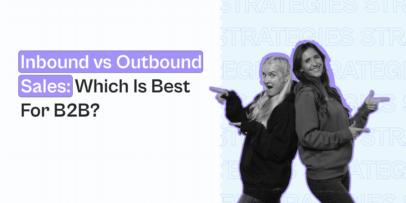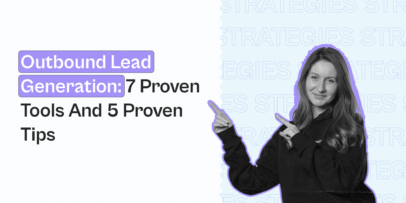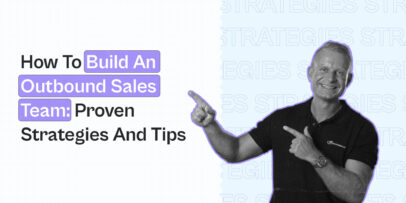Omnichannel vs Multichannel: What’s the Difference?
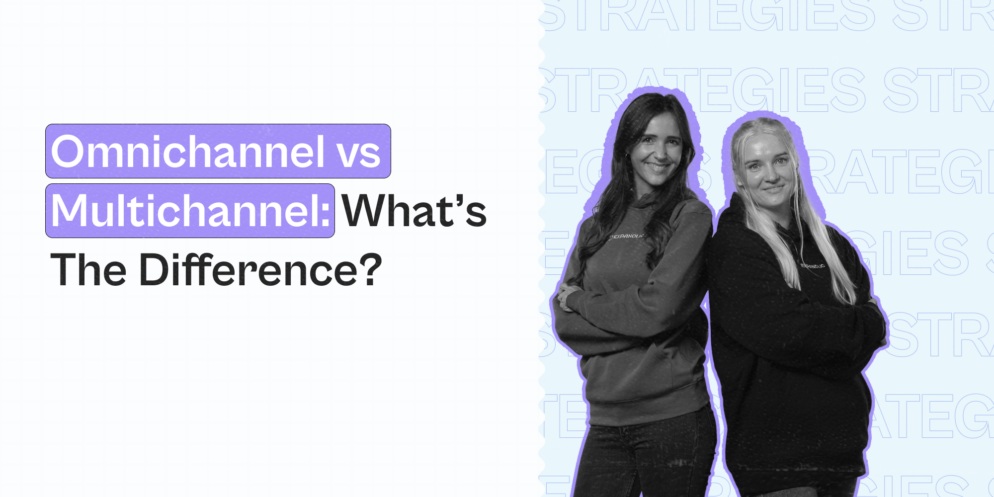
Wondering what the difference between omnichannel and multichannel is?
The 2 marketing channel concepts get thrown around a lot in the world of business, marketing, and sales, to the point where they’re often used interchangeably.
And to a point, yes, there is an overlap between omnichannel and multichannel marketing.
After all, both use more than one channel to communicate, reach, or sell to leads or customers.
But with that said, there are several key differences between the two terms.
At the end of the day, they’re pretty different in how they approach marketing and customer communication channels.
Essentially, it’s all about how you reach your customer.
With omnichannel marketing, the customer is at the center of it all. Then, you use all of your outreach channels to integrate and deliver constant, unified communication.
And with multichannel marketing, it’s all about using many channels to reach your leads, provide a customer experience, or engage with members of your target audience in some other way.
Now, if you’re wondering what this looks like in practice, what are some examples, challenges, and more of each channel – keep reading!
Below, we’ll cover everything you need to know about omnichannel vs multichannel marketing.
Here’s what you’ll learn:
- What Is Omnichannel Marketing? (Examples And Overview)
- What Is Multichannel Marketing? (Examples And Overview)
- Top Omnichannel Marketing Strategies For B2B Brands To Reach Leads On Multiple Channels

But wait!
Before you continue reading…
Are you in our private Facebook group, The LinkedIn Outreach Family, yet? Be sure to join and say ‘hi’ as we constantly discuss the latest omnichannel, multichannel, and other modern outreach strategies for LinkedIn and email.
Now, let’s get this ultimate guide to omnichannel and multichannel marketing started!
What Is Omnichannel Marketing? (Examples And Overview)
Going omnichannel in marketing is a favorite tactic of ours.
And it’s effective now more than ever when it comes to capturing attention.
Why is that?
It comes down to 2 simple reasons:
- You’re more likely to be seen when utilizing multiple touchpoints and marketing channels.
- You provide a more unified omnichannel customer experience, which means you’re more likely to stand out. So, for example, if a lead missed your LinkedIn connection request or forgot to reply when they saw your email follow-up, they’ll be more likely to remember your name and reply.
Omnichannel marketing places the customer at the center.
This means you’ll focus on their needs, wants, and pain points and provide a seamless, unified experience accordingly.
At the same time, you’ll be tailoring your communications based on each channel you’re engaging them on.
This allows the customer to easily digest information from any channel since they’re all working together to deliver a unified message.
But instead of looking at this as “spamming” your customers on every channel until they work with you, look at it like this:
- Customers know you pay attention to small details while tailoring each message to a specific channel.
- They can trust your business because you’re consistent in omnichannel communication and not copy-pasting the same sales message on each channel.
- They become loyal to a business they can trust. If not now, sometime later down the marketing funnel.
Why is omnichannel marketing effective?
Why is omnichannel marketing so effective?
A lot of it has to do with cutting through the noise.
When doing outreach marketing of any kind, business owners are already swarmed with cold emails, LinkedIn requests, and other pitches.
It can be incredibly easy to miss a connection request or a cold email, no matter how personalized they are.
So, with omnichannel marketing, one of your aims is to stand out.
A typical omnichannel flow can look something like this, as an example:
- You send a cold email.
- You follow up with a LinkedIn connection request and remind them about the email.
- You send a LinkedIn InMail with your value proposal pitch.
- Then, depending on whether or not the InMail was read, the flow continues with pre-set conditions. Such as automatically liking their post.

And yes, all this is automated. So, if someone replies at any point in your omnichannel strategy, the whole flow stops, so you can react personally based on what they said.
According to HubSpot, around 8 touchpoints are needed to generate a conversion.
And the more channels you’re interacting with your leads on, the more likely you are to convince them.
We’ll cover how multichannel marketing does this differently below. Keep on reading!
And finally, it goes without saying, your messages should be unified with a relevant value proposal.
Now, this brings us to the main challenges of omnichannel marketing.
Omnichannel marketing challenges
If done well, omnichannel marketing can pay off greatly.
Despite recognizing omnichannel experience as an essential marketing channel, marketers face several challenges when creating a seamless customer experience.
Such as:
- Inability to connect the dots in their messaging.
- Ineffective content strategy or no strong follow-up material.
- Improper utilization of marketing data and KPIs.
- Failure in implementation.
- And more.
Though it might seem time-consuming and expensive, it doesn’t have to be.
We’ll cover how to bridge the gap when it comes to omnichannel marketing and resolve these challenges below.
So, keep on reading!
Now, to recap so far, the 4 main pillars of omnichannel marketing include:
- Tailoring based on your target audience – Omnichannel outreach is very client-focused. It’s essential you know where your audience is, what are their pain points, their positions industry, and more, based on your ideal customer profile.
- Personalization – Another essential factor in all outreach. You’ll want to personalize beyond their first name and company names if you want to stand out. Additionally, you’ll want to include general information based on their industry that applies to most companies.
- Relevant content – You’ll want relevant content for each stage of your target leads’ marketing funnel and how product-aware they are of what you do. This will also be helpful for following up.
- The specific medium – Every marketing channel is different. You should know what channels your audience is at, how to reach them, and how to repurpose your messages accordingly. You should also know how to scrape profiles for each medium, your marketing automation tools, outreach templates, and more.
Now, for contrast, let’s look at how multichannel marketing works.
What Is Multichannel Marketing? (Examples And Overview)
As mentioned above, multichannel refers to using more than one channel to market, communicate, and reach your leads.
“Multi” suggests “many” and “omni” suggests “all.”
So, the critical difference is not rooted in whether or not prospects engage in all of the touchpoints in an online journey.
Similarly, as with omnichannel marketing, with a multichannel strategy, your goal is often to cut through the noise and reach your ideal customer.
Multichannel marketing is based on the fact that customers have more choices than ever regarding information overload and product choice.
Most people see anywhere from 4,000 to 10,000 ads each day.
And the increase in available channels has caused many marketing departments to increase their brand presence to develop a stronger relationship with their audiences.
In addition to the countless cold messaging coming in from email, text messages, company websites, social media, SEO, and so on.
With that said, multichannel marketing can still be a strong marketing tool. Let’s take a look.
Why is multichannel marketing effective?
First, let’s get this out of the way:
Multichannel marketing is not for everyone.
Multichannel marketing combines different channels to amplify your campaign’s reach, frequency of communication, and overall message.
Additionally, multichannel marketing can be more effective than single-channel strategies.
According to Optimove, multichannel campaigns received a 14% response rate. Meanwhile, single-channel campaigns received a response rate of 10.2%.

The average adult is connected to the internet from around 4 devices, which makes the potential of multichannel marketing much higher.
Simply put, marketers using only single-channel marketing are losing out on many potential touchpoints with their customers.
When it comes to multichannel marketing examples, brands use this strategy to:
- Improve customer service and education.
- Drive customer loyalty.
- Optimize for multi-device usage.
- Provide a seamless customer experience.
- Stay on top of their customers’ minds and more.
On a practical level, in the B2B or SaaS worlds, multichannel marketing most often includes:
- Retargeting Facebook ads.
- Targeting customers with ads on LinkedIn as well as Facebook.
- Using LinkedIn ads for sponsored content, personalized messaging (together with InMail messages), dynamic ads, and more.
You’ve probably come across dynamic or multichannel ads regularly while using different channels yourself.

Other channels used in multichannel marketing include:
- Email.
- Physical storefronts.
- Push notifications.
- SMS messages.
- Podcasts.
- Social Media.
- And more.
But of course, multi-channel marketing doesn’t come without its challenges.
So, let’s take a look at that first.
Multichannel marketing challenges
Whenever you’re dealing with multiple marketing channels, some of the obvious challenges that might come to mind include it being time-consuming and expensive.
But that’s not the only reason many marketers haven’t mastered this methodology yet.
Other challenges include:
- Difficulty staying consistent across different channels.
- Difficulties tracking sales analytics.
- Managing brand voice and repurposing copywriting for each medium.
- Project management becomes harder depending on your team size and workforce.
- And more.
And to overcome those marketing challenges, companies might want to:
- Create and maintain a single customer view (once again, based on the ideal customer profile).
- Establish a multi-channel digital marketing platform.
- And create a consistent customer experience funnel across all channels.
Now, let’s recap what we have so far.
The main key differences between omnichannel and multichannel marketing methods are the following:
Omnichannel focuses on the customer experience, is customer-centric, and focuses on providing quality customer support.
Multichannel, meanwhile, provides customer engagement, is channel-centric, and focuses on the number of channels.
Each method has its own pros and cons, and sometimes, it’s hard for marketers to decide which channel they want to focus on.
But if you’re looking for a simplified answer, here’s what you need to know:
Omnichannel marketing is ideal for outreach and lead generation. By following up consistently on multiple channels, your leads are more likely to reply and remember your cold email.
And multichannel marketing can be great for getting the word out about your company. Since this strategy focuses on the number of channels, you’re more likely to reach members of your target audience on all things sales ads, recruiting, brand promotion, and more.
So, if you’re thinking of the best approach to your marketing campaigns, keep that in mind.
Since omnichannel marketing is more practical, we’re now going to explore some strategies you can implement today!
Top Omnichannel Marketing Strategies For B2B Brands To Reach Leads On Multiple Channels
Your omnichannel strategy will differ based on your platforms or the community you’ve built for your brand.
Additionally, at this point, you should know what channels your target audience is on and how to target them.
Because that will differ based on your brand, we will cover multiple channels for B2B brands below.
So, with that said, let’s jump into some practical omnichannel strategies straightway.
1. LinkedIn groups and email outreach
LinkedIn groups are ideal for quickly finding your target audience.
All you have to do is type in a keyword, filter for groups, and you’ll find thousands of people interested in a specific topic.

Another reason LinkedIn groups are ideal for outreach is because you don’t have to be connected with its members to reach out to them!
Though, we do recommend joining the group, getting involved, and becoming a regular contributor for this campaign to work better.
But either way, you have something in common with your leads that you can mention in your outreach message.

You can combine this with a strong email outreach strategy to gain even bigger results.
To make things even easier, you can directly run omnichannel outreach campaigns like this from Expandi, including LinkedIn AND an email campaign.
Here’s how to set this up in Expandi:
- Go into Expandi and open the Campaign tab.
- Choose the Messenger Campaign, and link the LinkedIn group to import members from.
- Create a new group search under the Search section.
- Link the group(s) you want to scrape and click search.
- Once you’ve assigned all the selected members, you can build a regular LinkedIn outreach and email sequence without connecting to them first!
2. Scraping a Facebook group for LinkedIn and email outreach
This works similarly to the above campaign but is ideal if your target audience is in a Facebook group.
Facebook groups are really simple to scrape. And you can then reach out to them on LinkedIn as well as by email.
This might be the better choice depending on your target audience, as Facebook is also popular with marketers, developers, and business owners.
For example:

For this campaign, you’ll want to follow these steps:
- Join the group you want to scrape.
- Scrape the members of the profile and find their LinkedIn profiles with TexAu.
- Use Expandi to create an omnichannel outreach campaign for LinkedIn and email, as covered above.
- You’ll probably have to create a Connection campaign for this since you won’t be connected to them on LinkedIn beforehand.
- And finally, for this outreach, it’s highly recommended that you can “prove” why your solution is better than that of the competitor or the group you’re scraping.
For more info, learn more ways to get the most out of your competitor’s marketing strategy, including scraping their Twitter profile.
3. Hyper-personalized omnichannel outreach with dynamic GIFs and images
Finally, this is a recent favorite of ours.
With this proven outreach campaign, we’ve managed to skyrocket our reply rate to up to 55%.
And the reason for that is simple:
This omnichannel strategy focuses on humanizing your omnichannel outreach.
Here’s how it works:
- Your cold message has only up to 8 seconds to capture and hold your recipient’s attention. And the best way to do this is through visual assets. So, for this, we’ll be creating dynamic, personalized images and GIFs with Hyperise for an effective pattern interrupt.
- For that, you’ll want to record yourself performing an action (e.g., pointing to a whiteboard, toasting with a coffee cup, etc.).
- Then, you upload that image into Hyperise and add dynamic tags (such as {first_name}, {company_name}, {company_logo}, etc.).
- Then, integrate Hyperise with Expandi by pasting in the API code.
- Finally, you can start using dynamic GIFs like the one you see below in your LinkedIn and email outreach messages.
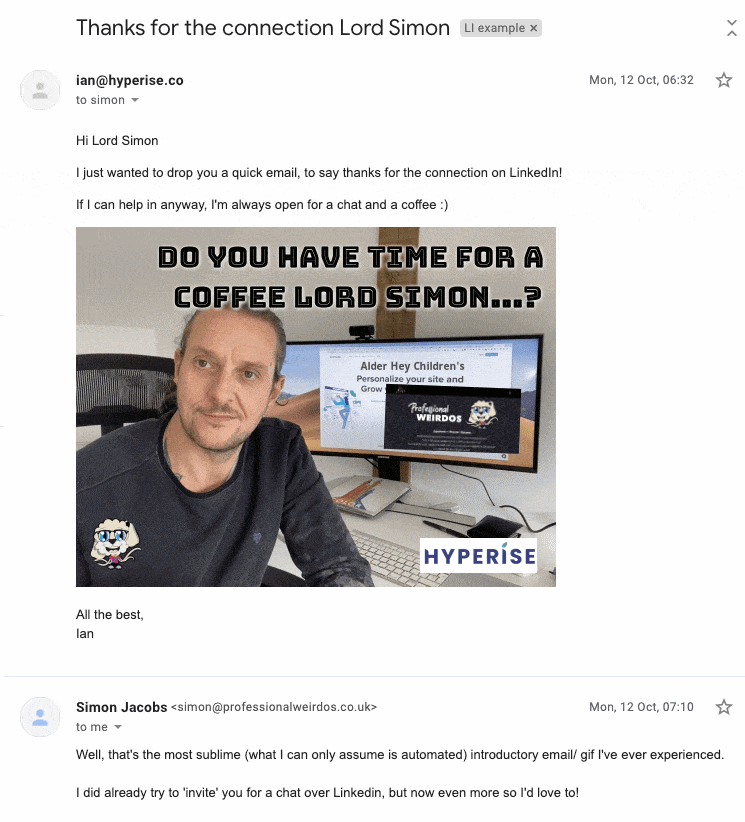
It doesn’t matter if you’re in B2B or B2C, as this is all H2H – human to human.
Now, if you’re wondering how to set this up in detail and examples of what sales templates to use, see our complete guide to using hyper-personalized GIF animations in your email and LinkedIn messaging.
Conclusion
Finally, that’s a wrap!
Hope you found this guide to omnichannel vs multichannel marketing helpful!
Before we sum up, let’s go over some of the most frequently asked questions on the topic:
- What is the difference between omnichannel and multichannel?
The key difference between omnichannel and multichannel marketing is how you use different marketing channels in your communications. Omnichannel means following an integrated approach across different channels to reach your ideal customer. Meanwhile, channels are not integrated with multichannel, and customer engagement is often siloed to the channels separately.
- What companies use multichannel marketing?
Since multichannel marketing is not for everyone, you’re likely to see bigger brands and companies use this methodology—companies like Apple, CVS, Disney, Starbucks, eCommerce sites like Under Armour, etc.
- What is the definition of multichannel?
“Multi” means “many.” And multichannel marketing refers to interacting with customers using a combination of indirect and direct communications channels—such as email, SMS messages, direct mail, mobile, and more.
And that’s a wrap!
If you found this guide useful and are ready to launch your own omnichannel marketing campaign, be sure to join our private Facebook group, The LinkedIn Outreach Family. In it, we’re discussing the latest marketing strategies and the latest growth hacks to get the most out of LinkedIn and email.
Finally, if you’re looking for the tools to get started, you can get started with a free, 7-day free Expandi trial and automate manual tasks like sending LinkedIn connection requests, following up, sending email messages, and more.
Only the best strategies will bring the best results
New articles straight to your inbox

